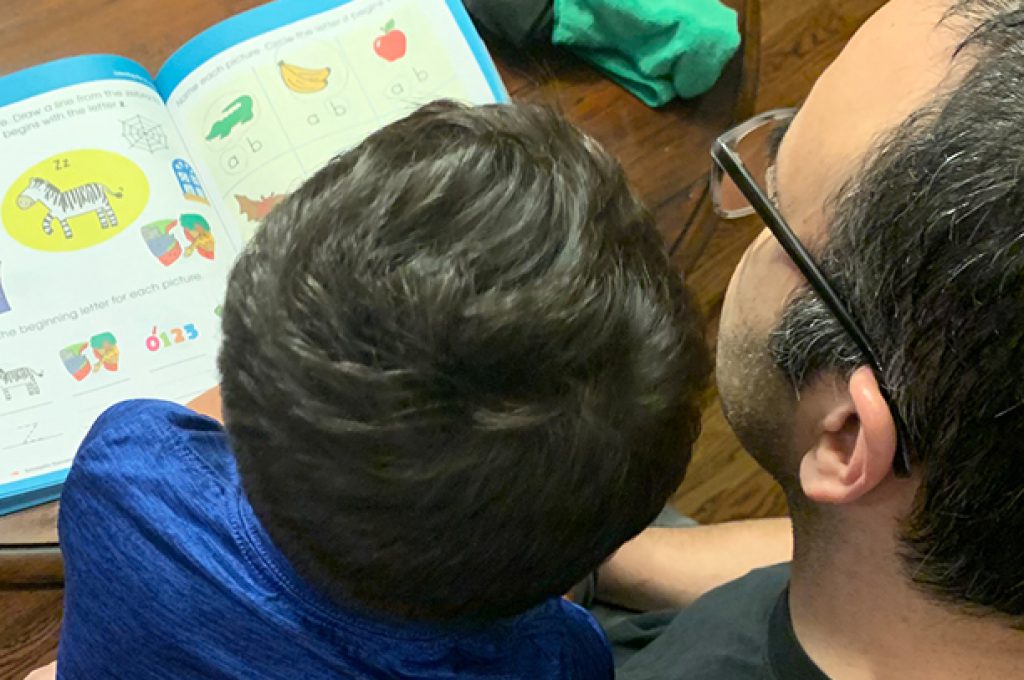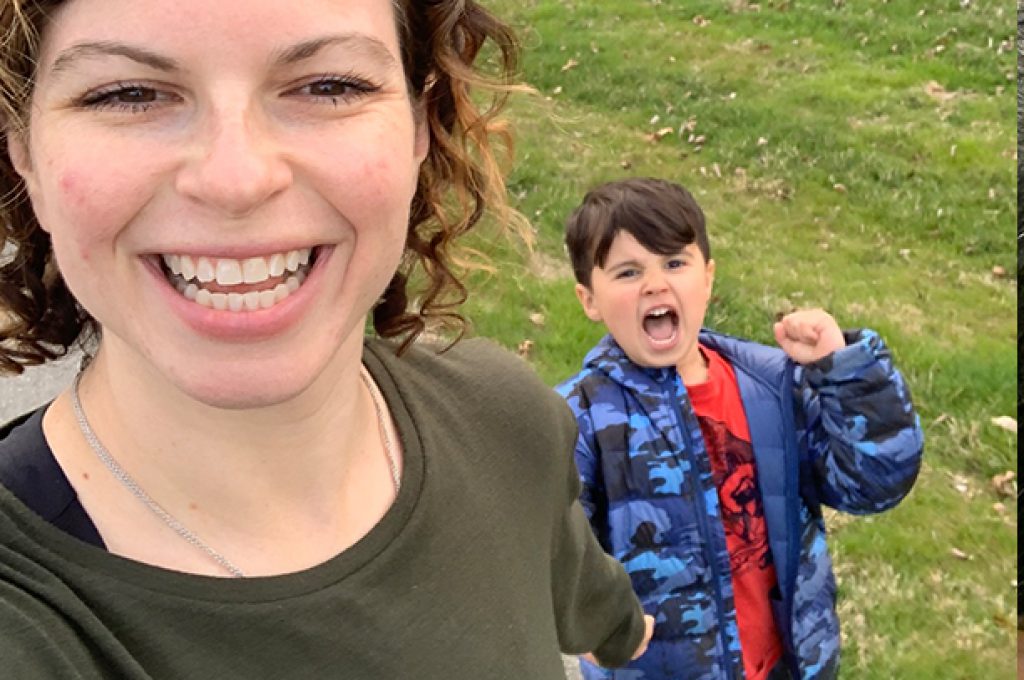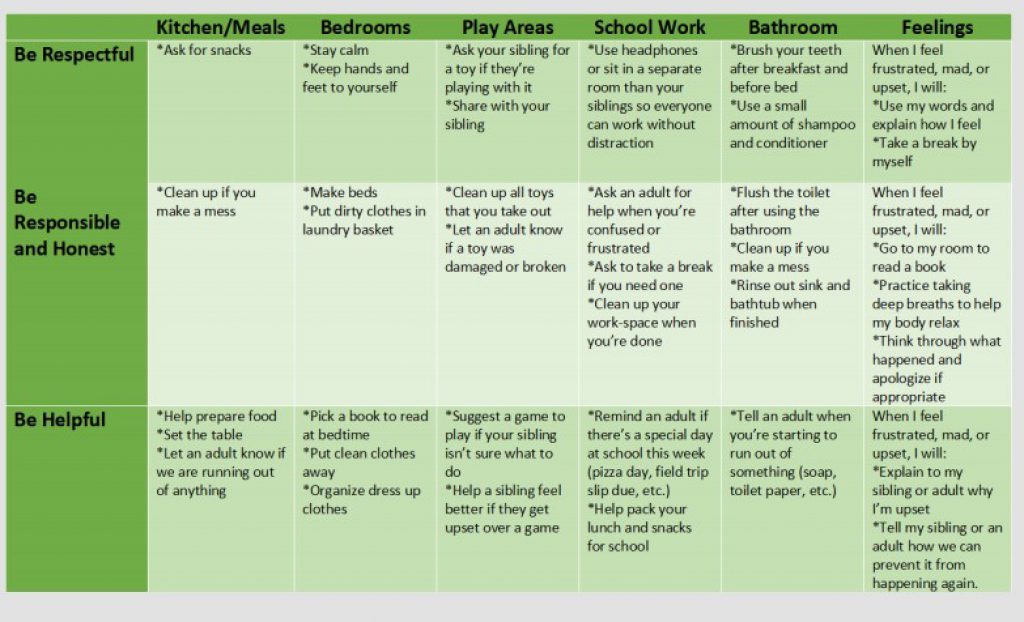Posted on April 20, 2020

Brynn Fallah’s son Thomas and his father, Maz, go over a school lesson at home.
Like a lot of parents, suddenly I’ve found myself simultaneously a full-time work-from-home and stay-at-home parent due to new Coronavirus restrictions that have shut down my state and are requiring all non-essential employees to work from home. As the two-week timeline was extended to a month and then two months, my thoughts went from “We can do this!” to “Oh boy” to “How are we ever going to get through this?”
One thing quickly became clear: for my own sanity I needed to settle into this new normal and figure out how my family and I would make these circumstances work (and hopefully do so with a sense of happiness). My first thought was to intentionally set up positive behavior supports for my family (which includes my 5-year-old son, Thomas, and my husband). My training is in school counseling and I’m currently employed as a project coach with the Delaware Positive Behavior Support Project at the University of Delaware’s Center for Disabilities Studies. So, I should have all the tools needed to make this work, right?
We agreed on Respectful, Positive and Safe. Family expectations (like a school’s) should be few in number (three to five), clear, positively worded, and easy to remember. They should reflect your core values as a family and now is an ideal opportunity with all this newfound time stuck inside together to sit down and talk about core values.
Next, we determined because this was a “new normal” we needed to set up a system to reward Thomas when he followed our expectations. I explained to him that I wanted to find items within our house that I could use to reward him for following our family rules (these are the tokens or tickets that you may be familiar with your child earning at school). My goal was to find something appropriate for a 5-year-old, sustainable, and honestly, something he would think is fun. We found a game with a bunch of small frogs to repurpose into our new tokens: “Fallah Frogs”.
Day 1 with the Fallah Frogs didn’t go well. Shocking, right? All I had told Thomas was that he needed to follow the family rules and follow our schedule and he would earn frogs. I wasn’t explicit. What’s more, my husband had made a grand declaration that the frogs were “dumb and didn’t work,” so he refused to use them. I couldn’t help but laugh (and cry) to myself… it sounded a lot like something I experienced in schools. If the system isn’t consistent across all educators in a school the success is impacted. So, if half of the adults in my household thought the frogs were dumb, how could we possibly be successful? I regrouped and was determined to calmly show both my husband and Thomas that this could work.

Fallah and her son Thomas practice outdoor social distancing amid the coronavirus pandemic.
Over the course of the first few days things evolved. We did some problem solving. I loosened our daily schedule from being planned by the half hour to this: the morning is for learning and the afternoon is for play. Instead of rewarding a Fallah Frog for every perfectly implemented half hour, I made a check list of things Thomas could earn frogs for. The list includes explicit, positively worded, daily behaviors like:
- Get dressed
- Brush teeth
- Make bed
- Wash hands for 20 seconds
- Listen the first time
- Work on educational apps or worksheets
- Work or play independently during Mommy’s work calls
- Get exercise everyday (outside or video)
Thomas trades in 10 frogs for extra iPad time in the evening. For 15 frogs, extra iPad time plus a snack of his choice. This has Thomas working intentionally for frogs, counting them throughout the day, and even reminding me of times he should be earning them. It also gives me and my husband structure to ensure we are giving him feedback when he does the right things … and not simply correcting him when he makes a mistake.
We’ve been excited to see some initial success, but we have also realized that since these circumstances are new to all of us, there is a great need to teach new behaviors right now. At five, Thomas knows how to get dressed, brush his teeth and make his bed, but at some point, those behaviors needed to be taught. What he doesn’t know how to do is to not use my morning work Zoom meetings as an opportunity to put on a performance for my co-workers. He doesn’t know how to learn from home in any structured way. He honestly doesn’t even really know how to play independently. So, we’re teaching him.
My favorite slide that the DE-PBS Project uses in professional developments is:
“If a child doesn’t know how to read, we teach.”
“If a child doesn’t know how to swim, we teach.”
“If a child doesn’t know how to multiply, we teach.”
“If a child doesn’t know how to drive, we teach.”
“If a child doesn’t know how to behave, we….
…teach? ….punish?”
“Why can’t we finish the last sentence as automatically as we do the others?”
-Tom Herner
We are teaching new behaviors, new expectations. While he is learning, we instantly reward him a frog for doing any of the behaviors on our checklist. When he does one, I say, “Thomas – I’m giving you a frog for listening the first time. Great job. I’m proud of you for making a good choice.” There are many variations to this praise, but using immediate feedback helps tie the behavior to why he is earning a frog (and is therefore more likely to understand and repeat the behavior). We also reward other behaviors not officially on the list but fall into one of our family rules. For example, telling the truth (responsible), getting out of the way when a car comes on our evening bike rides (safe) and reminding us of having a good attitude even when we’re stressed (positive).
Our next step will be creating a home matrix, which will define desirable behaviors even more and teach my son how they’re organized by our expectations. For my family, I made the choice to do one thing at a time since my initial approach overwhelmed them, but the home matrix would look something like this that my colleague recently created for her home:

Fallah created a home matrix, which will define desirable behaviors even more and teach her son how they’re organized by expectations.
Our plan is far from perfect but here’s what we’re working on:
- Being intentional
- Looking at what’s working and what isn’t working and re-evaluating
- Using more praise than correction
- Using pre-correcting, prompting and redirecting when teaching the new and old behaviors
- Providing as much positive, immediate and explicit feedback as possible every day
We are learning this new system and new life at home as much as Thomas is, so my husband and I are working on being patient with him and ourselves. We are a normal family, so we still have moments of exasperation, yelling and time we need to just be alone. However, even my husband has come around to the frogs and is slowly learning how to use them. What a relief to discover that even husbands can learn new behaviors!
